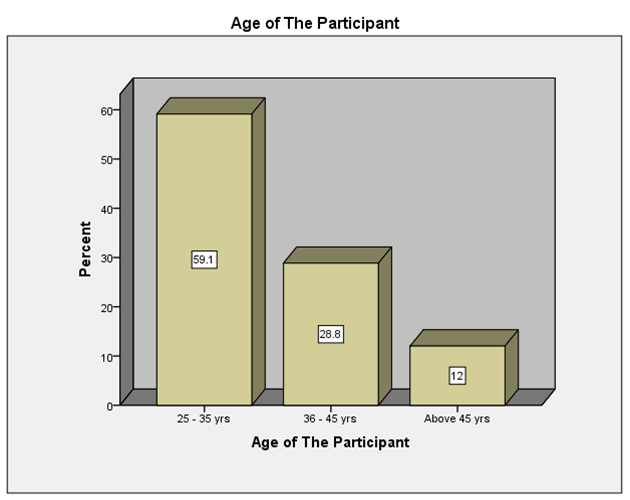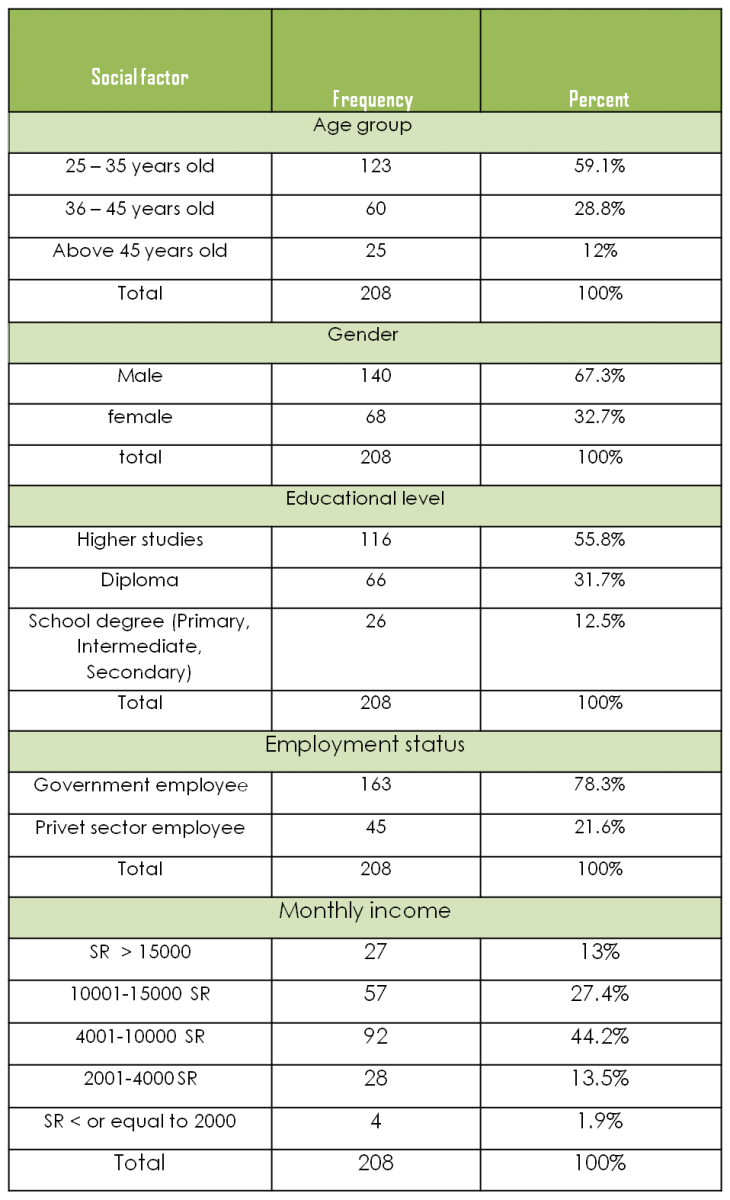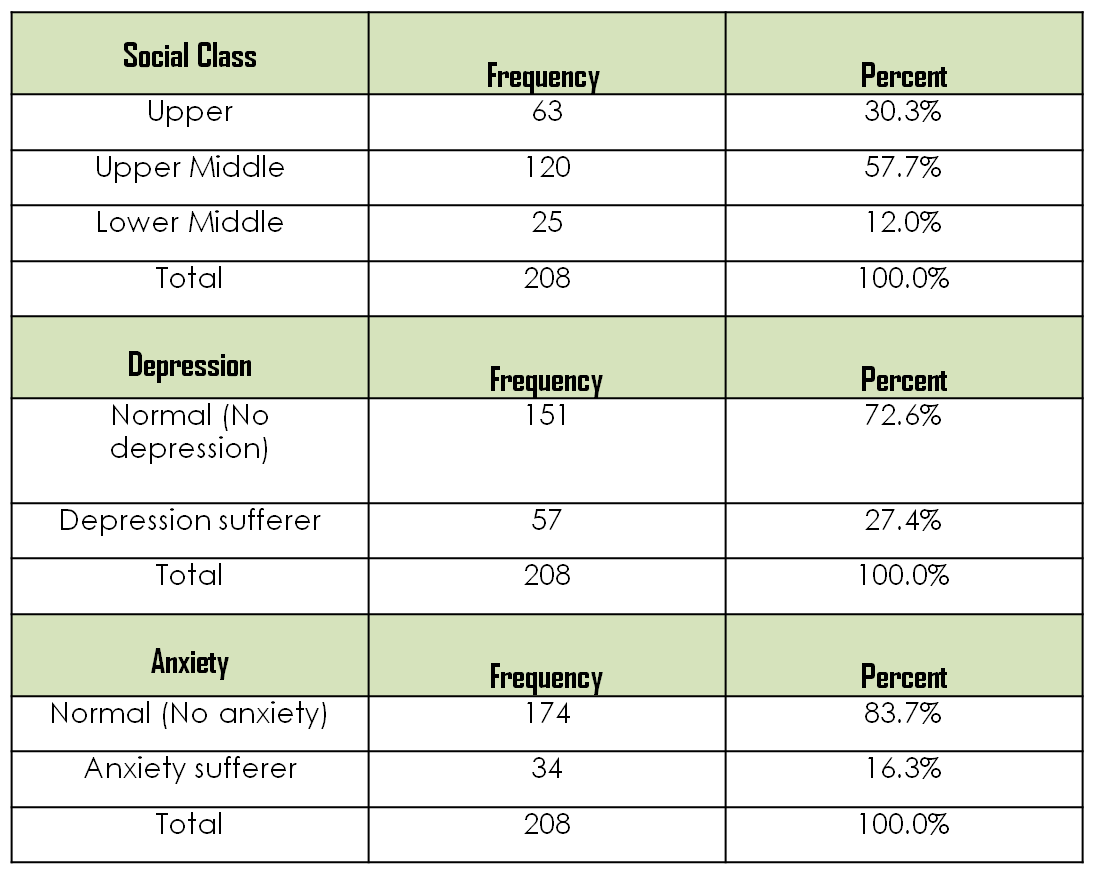


Theme
Clinical Sciences 2
INSTITUTION
Not Available

Mental health and socioeconomic status are important determinants of an individual’s wellbeing. A number of inter-related factors including education, health beliefs and behaviour, occupation, income, access to health services and the environment in which people live determine the socio-economic disadvantage and mental health quality. The objectives of this study were to determine the effect of socioeconomic status on mental health among riyadh region population, saudi arabia.
It was an institutional-based descriptive study. Data were from 208 participants aged 25 years and above, from both Riyadh and Majmaah cities. Data was collected by a pre-coded and pre-tested questionnaire which was consisting of two main domains that subdivided into three different questionnaires (Modified Kuppuswamy socioeconomic scale, PHQ-9 Questionnaire for Depression and GAD-7 Questionnaire for Anxiety) to assess the degree of interaction between socioeconomic status and mental health.
Most of the participants were of upper middle class (57.7%), euthymic or non-depressed (72.6%) and non-anxious (83.7%). On the other hand (27.4%) and (16.3%) of the participants had depression and anxiety respectively.
Females were more anxious than males (p>0.003, 9.1%) while males suffered from depression more than females (p>0.046, 15.4%). In our study, social class, age, educational level, employment status and monthly income were statically non-significant with depression and anxiety.
Figure (1) shows the distribution of age among participants.
Table (1) shows the socioeconomic characteristics of the participants.
Participants age groups: (25-35 years old), (36-45 years old) and (Above 45 years old) were 123 (59.1%), 60 (28.8%) and 25 (12%) respectively. Males enrolled in the study were 140 (67.3%), while females were 68 (32.7%).
Regarding the educational level, most of the participants were of higher studies (Bachelor, Master, PHD) degree 116 (55.8 %'), diploma 66 (31.7%) and school (Primary, Intermediate, Secondary) degree 26(12.5%).
Table (2) shows descriptive data of the social class.



The study concluded that the prevalence of anxiety and depression is high among the population of Riyadh and Majmaah of Saudi Arabia. Depression and anxiety are associated with gender; males are mostly affected than females by depression while females compared to males are mostly affected by anxiety.
Several literature reviews have established a correlation between socioeconomic status and mental health changes in different parts of the world, but very few studies have been conducted for that matter in Saudi Arabia and gulf countries.
Generally, men and women of higher socioeconomic status (SES) have better mental health, but still little is known about how socioeconomic factors are associated with changes in health.
Illiteracy or poor education is a consistent risk factor for common mental disorders. Some studies have also demonstrated a dose response relationship between educational level and the risk of such disorders.
The authors would like to acknowledge governmental and private sectors' administrators and employees for their contribution to the success of this research.
1. Williams JS, Cunich M and Byles J. The impact of socioeconomic status on changes in the general and mental health of women over time: evidence from a longitudinal study of Australian women. Int J Equity Health., 2013; 12: 25.
2. Araya R, Rojas G, Fritsch R, Acuna J, Lewis G. Santiago Mental Disorders Survey: prevalence and risk factors. British Journal of Psychiatry., 2001; 178: 228-33.
3. Hussain N, Creed F, Tomenson B. Depression and social stress in Pakistan. Psychological Medicine., 2000; 30: 395-402.
4. Araya R, Lewis G, Rojas G, Fritsch R. Education and income: which is more important for mental health Journal of Epidemiology and Community Health., 2003; 57: 501-5.
5. Kahn RS, Wise PH, Kennedy BP, Kawachi I. State income inequality, house- hold income, and maternal mental and physical health: cross-sectional national survey. BMJ., 2000; 321: 1311-5
6. Sturm R, Gresenz CR. Relationship of income inequality and family income to chronic medical conditions and mental health disorders: national survey. BMJ., 2002; 324: 20-4.
7. Weich S, Lewis G, Jenkins SP. Income inequality and the prevalence of common mental disorders in Britain. British Journal of Psychiatry., 2001; 178: 222-7
8. Rumble S, Swartz L, Parry C, Zwarenstein M. Prevalence of psychiatric morbidity in the adult population of a rural South African village. Psychological Medicine 1996.
9. Brenner, M. H. (1973). Mental illness and the economy. Cambridge, MA: Harvard University Press.
10. Link, B. G., Dohrenwend, B. P, & Skodol, A. E. (1986). Socio-economic status and schizophrenia: Noisome occupational characteristics as a risk factor. American Sociological Review, 51, 242–258
 Send Email
Send Email